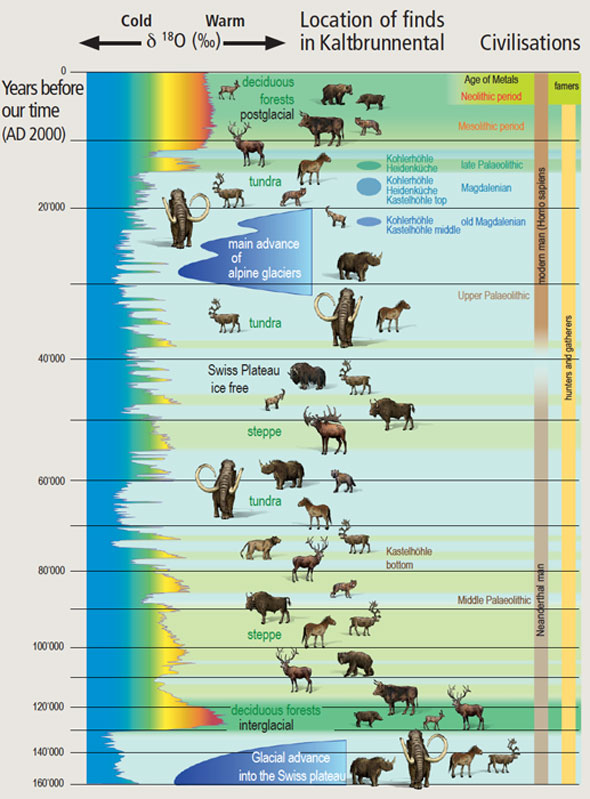Caves as historical archives
The caves in Birstal are important archaeological archives. Thanks to natural protection from weathering (erosion), traces of prehistoric hunters and gatherers can be found in many places. These natural shelters have been visited time and again since the age of the Neandertals more than 50’000 years ago.
Despite the low population density during the early Stone Age, the finds from the caves along the Birs provide us with a detailed picture of human history. It is known that there were occasional raids by Neandertals in the Kaltbrunnental. Modern man, who appeared in Europe around 40’000 years ago left traces in the Birstal after the retreat of the alpine glaciers around 23’000 years ago. But continuous settlements were established only later, from ca 19’500 years before our time. More frequent archaeological finds date from about 16’000 years ago.
During the last million years, the climate of the earth suffered massive changes. Within only a few generations temperatures could drop substantially, leading to an ice age, or rise to the point where glaciers disappeared altogether. The duration and intensity of these changes vary considerably. Many of these climate changes happened very rapidly (in both directions). Within just a few generations fundamental upheavals influenced the environment, causing great changes in fauna and flora. Global temperatures in the way we know them today, occurred only during a few short periods in the last 1’000’000 years. During two thirds of this time the earth’s atmosphere was quite cold. Here the in the Jura the climate was cold and dry. During the last ice age (about 110’000 to 11’00 years ago) the Midlands were severly covered by glaciers between 32’000 and 20’000 years ago.
Animal and plant finds show the preponderance of a continental climate during cold periods. The land was covered by a generally treeless tundra on which lived herds of reindeer, wild horses, bison and mammoths as well as rhinos and musk oxen. Also widespread were the great predators such as wolves, hyenas, lions and cave bears. In times of a more beneficial climate dense broad-leaved forests spread out over Europe, as today, with their corresponding fauna of stags, roe deer, wild boar and aurochs. But forest elephants and forest rhinos roamed here too. During the last interglacial period 125’000 years ago, even hippos lived in the Rhine.
In this ever-changing environment Neandertals, as well as modern man, managed to survive without problems. As an adaptable huntergatherer without specific ecological needs, man, unlike animals or plants, was able to adapt to the changing circumstances without having to leave the area for other habitats. Migration of animals in Birstal can be demonstrated thanks to genetic examination. The wild horses living at the end of the ice age are not the direct descendants of those at the time before the last glaciation.
Dinosaurs?
The dinosaur footprints in Courtedoux (JU) are approximately 150 million years old. They have their origin in a time long before the Jura mountains with their karst areas and caves came into existence.
